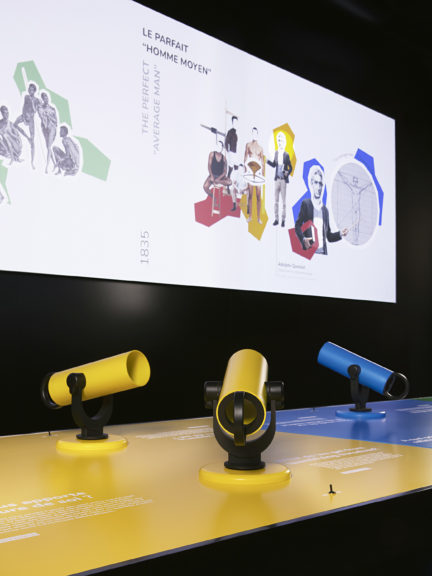Things that Talk: Opening Night
This is an astonishing exhibition. Centred on a single scientific object, Things that Talk offers the public the opportunity to discover its historical depth through new and playful forms of interaction. The object is revealed through the many turbulent stories – sometimes controversial, always surprising – that it has generated. Resulting from a collaboration between the EPFL Laboratory for the History of Science and Technology and the EPFL+ECAL Lab, Things that Talk does not look back at the origin of these scientific objects, but reveals their uses and consequences. The exhibition also links them to contemporary issues.
The space opens on a beautiful brass object, with a sleek appearance, dating from the early 19th century: a dynamometer graces the entrance. People familiar with this instrument will associate it with its primary function: measuring physical strength. The exhibition highlights the richness of its unexpected uses.
Visitors are welcomed to sit around a large table. A viewfinder system invites them to interact with the environment to explore the narratives presented there. The many meanings and uses of this dynamometer gradually appear.
The scientific interpretations of the time are displayed and come to life: at the beginning of the 19th century, this measuring instrument was used to demonstrate that “civilised man” had not become weak as Rousseau thought he would; at the end of the century, it could be used to measure willpower, and even served as a witness in a murder trial! Some of these considerations arouse indignation or ridicule today.
The exhibition takes it a step further by suggesting a link between these past stories and contemporary themes. For example, the connection between this ancient measure of human strength and the “Quantified Self”, i.e. the practice of self-tracking through wearable devices and smartphones, initiates reflection on today’s tools. The exhibition thus experiments with an original approach, based on the most recent work in the history of science, interaction design creativity and the possibilities of digital technology.
This approach is the fruit of collaboration between two EPFL units. On the one hand, the Laboratory for the History of Science and Technology (LHST), whose mission is, among other things, to promote the UNIL-EPFL Collection of Scientific Instruments, whose historical work has made it possible to document the secret lives of the chosen instruments and to offer cross-interpretations. On the other, the EPFL+ECAL Lab, the EPFL design research centre, which has imagined how to turn this new historical knowledge into an experience linked to our daily lives. The design work begins with an experimental exhibition concept to generate a physical engagement with the content, thereby stimulating debate and social interaction.
Unlike the cabinets of curiosities which feature a multitude of rare specimens, this exhibition focuses on a small number of everyday objects and avails itself of the means, via digital technology, to rediscover their richness and character through the abundance of their stories.
This project required the design and development of interaction devices and the conception of a language able to associate the various elements in a coherent form. Thus, several viewfinders create interaction with the texts and images projected on the walls, giving life to these eventful stories. Designed as an experiment, the exhibition will serve to establish new forms of interaction with heritage objects, not only to enhance them, but also to make them resonate with the present.
Three objects and their stories will be successively unveiled at the EPFL Pavilions:
the Dynamometer, from 14 to 24 April 2022
the Globe of Mars, from 28 April to 8 May 2022
the Crookes Tube, from 11 to 29 May 2022


EPFL+ECAL LAB
Direction
MAS in Design Research for Digital Innovation
Project Management
Creative Coding & Software Engineering
Delphine Ribes, Dr Cédric Duchêne, Yves Kalberer, Gabriel Luthier
Sound Design
Scenography
Graphic Design
UI/UX Psychology
Photography
© EPFL+ECAL Lab / Calypso Mahieu
CREDITS LHST
Content and Curation
Pr Jérôme Baudry, Director
Dr Ion-Gabriel Mihailescu, Postdoctoral researcher
Dr Simon Dumas Primbault, Postdoctoral researcher



